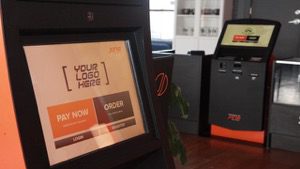Self-service kiosks have been proliferating for the last few years. Having already seeing success in banking, gasoline, and grocery, self-service kiosks are now popping up in more and more areas of consumer life. Kiosks are increasingly being used to help supplant the need for hiring staff, enabling customer personalization, and speeding up transactions.

As user experience professionals are increasingly being asked to design these types of self-service experiences, we felt it would be timely to spell out a few design principles that lead to a more positive outcome for consumers:
- Set Expectations. At the beginning and close of a transaction, clearly communicate key items such as: acceptable forms of payment (e.g. credit or debit card only), possible language choices, item pick up, where to go next, etc.
- Clear Call to Action. If possible, each screen should ideally have only one clear call to action. When using buttons for the call to action, using a consistent color and placement for it leads to greater usability.
- Simplify. In addition to a single call to action, keep the number of items to scan and choices to make at a minimum. There is a certain social pressure, especially when using a kiosk with a queue behind you that causes most to want to move quickly.
- Lower Third of the Screen. Given the recent trend towards larger and larger screens for kiosks, it is tempting to use all of this real estate. However, we have found it best to focus the primary calls to action to be on the lower third of the screen. Some call this supporting the “lazy elbow” enabling consumers to process transactions as quickly and easily as possible.
- Large Buttons and Links. Be sure to create large touch targets for users to access. Doing so will prevent users from having to touch a button or a link multiple times to perform an action.
When these design principles are followed, we’ve found a much greater chance at success. However, with any interaction design project, we’ve found it best to vett our ideas with usability testing early and often.